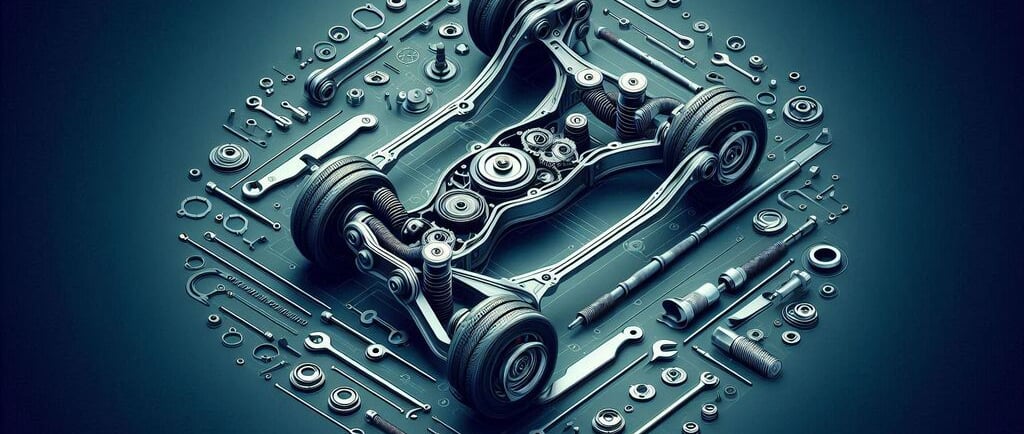Control Arms: Connect wheels to the frame, allowing movement and stability.
When it comes to driving comfort, stability, and vehicle handling, control arms are among the unsung heroes of the suspension system.
CHASSIS AND FRAME PARTS
11/13/20244 min read


Control Arms: Connecting Wheels to the Frame for Smooth Movement and Stability
When it comes to driving comfort, stability, and vehicle handling, control arms are among the unsung heroes of the suspension system. These essential components connect the wheels to the vehicle’s frame, allowing controlled movement and flexibility. If you’ve ever experienced a bumpy ride or noticed uneven tire wear, control arms could be the issue.
In this article, we’ll explore what control arms are, how they work, the types available, and signs that they might need replacing. Understanding control arms can help you keep your vehicle running smoothly and make better maintenance decisions.
What Are Control Arms?
Control arms are pivoting links that attach the wheel hub to the vehicle’s frame. They play a crucial role in the suspension system by controlling the up-and-down motion of the wheels, which is essential for smooth driving and vehicle stability.
Key Functions of Control Arms
Maintaining Stability: Control arms hold the wheels at the proper angle, which helps ensure that your vehicle stays balanced on the road, especially during turns.
Absorbing Shock: With the help of ball joints and bushings, control arms absorb road bumps, providing a more comfortable and stable ride.
Control arms come equipped with bushings and ball joints, which are necessary to reduce friction and absorb vibrations. Over time, these parts can wear out, which can impact the overall performance of the suspension.
How Control Arms Work in the Suspension System
The control arm connects the suspension system to the wheel hub, allowing the wheels to move vertically while keeping them stable and in alignment with the vehicle’s frame. Here’s a quick breakdown of how it functions within the suspension:
Connection and Movement: The control arm is linked to the frame at one end and the wheel assembly at the other. It allows the wheels to move up and down independently of the vehicle body.
Support for Ball Joints and Bushings: The arm houses ball joints and bushings, which enable smooth movement and help absorb road vibrations.
Ensuring Proper Alignment: Control arms maintain the wheels’ correct position relative to the frame, ensuring stable handling and minimizing tire wear.
Types of Control Arms
Depending on the type of suspension system, control arms come in various designs:
Upper and Lower Control Arms: Many vehicles have both an upper and a lower control arm, especially those with double-wishbone or multi-link suspension setups. Each provides support for different parts of the suspension system.
Single Lower Control Arm: In some vehicles, particularly those with strut-type suspension, a single lower control arm is used to control wheel movement.
Signs of Worn-Out Control Arms
Control arms are durable, but like all mechanical parts, they experience wear and tear. Driving on rough roads or carrying heavy loads can accelerate wear, leading to issues with vehicle stability and control. Here are some common signs that it might be time to inspect or replace your control arms:
1. Vibrations or Clunking Noises
If you hear clunking sounds when driving over bumps or notice vibrations in the steering wheel, it’s a possible sign of worn bushings or ball joints in the control arm. This often means the control arm isn’t able to stabilize the wheel as effectively as it should.
2. Uneven Tire Wear
Worn control arms can cause your wheels to be out of alignment, leading to uneven tire wear. If you notice that your tires are wearing more on one side, it may be due to a control arm issue that’s causing improper wheel alignment.
3. Poor Handling
Control arms are essential for steering stability. If you experience poor handling, especially during turns or at high speeds, the control arms could be worn. This may make your vehicle feel “loose” or less responsive.
Maintenance Tips for Control Arms
Proper maintenance can help extend the life of your control arms and improve the overall handling and performance of your vehicle. Here are some tips:
Inspect Control Arms Regularly
Regular inspections can help detect wear before it leads to more serious problems. Pay attention to the bushings and ball joints, which are typically the first components to wear out.
Replace Worn Bushings and Ball Joints
If the bushings or ball joints are worn but the control arm itself is in good shape, you might only need to replace these specific parts. Quality replacements can restore your control arm’s performance without the expense of replacing the entire assembly.
Drive Carefully on Rough Roads
If possible, avoid rough or uneven roads that can put excess strain on the control arms. This can help prevent premature wear and reduce the likelihood of damage.
The Role of Control Arms in Vehicle Safety
Control arms aren’t just about comfort—they’re essential for safety. Worn-out control arms can affect your vehicle’s stability, making it harder to control. Particularly during emergency maneuvers, a stable suspension can make all the difference. In fact, studies indicate that suspension issues, including worn control arms, can increase stopping distances and reduce handling accuracy. Keeping your suspension in top condition is an important aspect of safe driving.
Conclusion: Keep Your Control Arms in Check for a Smoother Ride
Control arms are essential for connecting your wheels to the frame, allowing for smooth movement and vehicle stability. They may not always be top-of-mind, but understanding their role can help you identify potential issues and maintain your vehicle effectively. Regular inspections and timely maintenance can prevent control arm issues from turning into major repairs or affecting your safety on the road.



